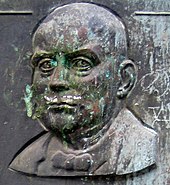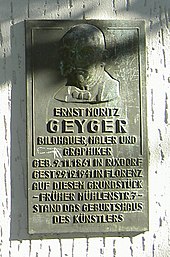Ernst Moritz Geyger
Ernst Moritz Geyger (born November 9, 1861 in Rixdorf ; † December 29, 1941 in Marignolle near Florence , Italy ) was a German sculptor , medalist , painter and etcher . He is considered a representative of the Berlin School of Sculpture .
Life
The Geyger family left their home in Neufchatel around 1824 and settled partly in the area around Berlin , the former municipality of Deutsch-Rixdorf , and partly in the Hanover area . His father Gustav Ernst Geyger, rector of the 77th community school in Berlin, married Albertina Lisetta Ida Brückner in 1858. Geyger had two siblings, including Elfriede, called Lisa, who, like her siblings, came from a "teacher dynasty".
Ernst Moritz Geyger was born on November 9, 1861 at today's Karl-Marx-Platz 16-18, the former Mühlenstraße 7. A plaque by Otto Drengwitz on the house commemorates the Rixdorf artist.
From 1877, at the age of sixteen, Geyger began an artistic training in the painting class at the art school in Berlin and moved to the Berlin Art Academy until 1884 . Here he continued his education as a student of Paul Thumann , Otto Knille , Max Michael and Paul Meyerheim . After graduating from the university and trying in vain to find accommodation in Anton von Werner's master studio, Geyger worked as a freelance painter. In addition, he devoted himself to graphics , but switched to etching and copperplate engraving in his works from 1886. During this time, his parodying depictions of animals were very popular, for example the crane as a “preacher in the desert”, “the elephant at the toilet” and “the great monkey disputation”. Since painting was no longer satisfactory for him, he also turned to sculptural work from 1886 onwards, without having undertaken appropriate training.
Soon he continued his artistic education by visiting Florence and Berlin . In 1893 Geyger received a professorship at the Dresden Academy as head of the copperplate master's studio. Not accepting the academic pressure, he left Dresden after only five months. He now oriented himself again towards the study of foreign art. He used a stay in Paris to control the production of his parchment prints and casts of small-scale silver and bronze works .
In 1895 he settled near Florence and set up a workshop in the Mediceer Villa Marignolle. He had a school studio in Florence and a second in Berlin. In 1902 his most famous work, which can be seen today on the banks of the Dresden-Neustädter Elbe and in the park of Sanssouci Palace in Potsdam, was the often copied archer .
From 1900 to 1904 Geyger stayed in Berlin again. Here he sued the artist Max Klinger in 1903 for defamation, because Klinger had claimed in a newspaper article that he had wanted to embezzle foundation funds. Geyger won that trial.
After an appointment in 1918 as professor of the master's atelier for graphics at the Berlin Academy , Geyger remained in this position at the university until March 31, 1927. He then chose Florence as his permanent residence.
After the " seizure of power " by the National Socialists , Hitler acquired some of Geyger's pictures and in 1936 awarded him an honorary salary. In 1938/39 Geyger took part in the second German architecture exhibition in the Munich House of German Art with the object archer on Königsufer in Dresden . Just a few days before his death, Geyger received the Goethe Medal for Art and Science in 1941 .
His ashes were buried in the Ulm cemetery.
Works (selection)
- 1883: Animal study (picture), Luther picture (picture)
- 1895: the giant
- 1895: Archer (copper driving carried out in 1901 by Gustav Lind), Sanssouci Park, Potsdam
- 1901: Bull , in the Humboldthain Volkspark , Berlin
- 1902: Archer (bronze figure), re-installation in 1936 in the perennial garden on the Neustädter Elbe bank in Dresden as a political gesture
- 1903: Malay Bear (bronze figure), Archer (bronze figure)
- Monkey pulling out thorns , present in the Albertinum in Dresden
- 1912: Pecunia non olet (picture)
- 1915: Märchenbrunnen (formerly: German Forest , also symbol of the Waldesdom , fountain with bronze figures), see Märchenbrunnen in Schulenburg Park
Archer on the banks of the Elbe in Dresden
Archer on the Trammplatz in Hanover
Illustration for Friedrich Nietzsche , Der Riese , in: Pan (1895)
Posthumous honors
- Plaque
- Karl-Marx-Platz 16-18, Berlin-Neukölln
- Street naming
- Geygerstraße between Sonnenallee and Donaustraße, Berlin-Neukölln, name given on March 27, 1912 by the Rixdorf municipal administration
literature
- Peter Bloch, Sibylle Einholz , Jutta von Simson (eds.): Ethos and Pathos - The Berlin Sculpture School 1786-1914 . Gebr. Mann, Berlin 1990, ISBN 3-7861-1599-0 , p. 109 f.
Web links
- Ernst Moritz Geyger Gallery Saxonia
- Art walks in Berlin and the surrounding area: Ernst Moritz Geyger
- Geyger.de
Individual evidence
- ↑ artist. Ernst Moritz Geyger. German Society for Medal Art V., accessed on November 29, 2014 .
- ^ A b c d Martin H. Schmidt: Sculptures in Berlin: The "archer" by Ernst Moritz Geyger. (PDF) A Berlin sculptor and his most popular work. Association for the History of Berlin, February 1992, pp. 1–9 , accessed on January 3, 2012 .
- ↑ Hildegard Brenner: End of a bourgeois art institution. The political formation of the Prussian Academy of the Arts from 1933 , Part C .: Departments for the fine arts and music , Munich: Oldenbourg Wissenschaftsverlag, 2010, ISBN 9783486703603 , p. 130; also as a PDF document from degruyter.com
- ↑ Berlin in Past and Present , 1994, p. 168
- ↑ a b Short biography of Geyger from Meyers Lexikon 1905; on zeno.org
- ↑ a b c d Ernst Klee : The culture lexicon for the Third Reich. Who was what before and after 1945. S. Fischer, Frankfurt am Main 2007, ISBN 978-3-10-039326-5 , p. 182.
- ↑ Geygerstrasse. In: Street name lexicon of the Luisenstädtischer Bildungsverein (near Kaupert )
| personal data | |
|---|---|
| SURNAME | Geyger, Ernst Moritz |
| ALTERNATIVE NAMES | Geyger, Ernst |
| BRIEF DESCRIPTION | German sculptor, medalist, painter and etcher |
| DATE OF BIRTH | November 9, 1861 |
| PLACE OF BIRTH | Rixdorf |
| DATE OF DEATH | December 29, 1941 |
| Place of death | Marignolle near Florence ( Italy ) |







